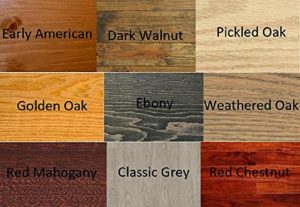Wood Stairs » Stair Remodeling » Best Wood Stair Finishes & Stains
Wood finishes can make or break a wood project. As you begin working on any kind of home improvement or renovation project that includes wood, it’s important to know what kind of wood you’re working with, which often can be various types within a single project. Different types of wood have different types of needs including various finishes and stains. If you are looking to discover the best wood stair finishes and stains for your project, you’ve come to the right place. Whether you plan to DIY the project or hire someone to help, it’s a good idea to have a plan in place for what you need for your woodwork project.
The Importance of Finishes and Stains:
When it comes to woodwork, stains come in a variety of shades and types – some work better for certain types of wood than others. Additionally, stains are completely optional. This is why you sometimes see wood furniture and home fixtures that look like the natural grain of wood that it is.
However, finishes are a completely different story. In order to protect your wood furniture, building elements or home fixtures, you must use some type of finish to complete the project or it will split, crack and deteriorate over time, especially when exposed to moisture and other weather elements particularly snow, ice, water and sun.

Types of Wood Finishes:
There are at least 10 types and dozens of brands of wood finishes to choose from. Each type of stain has a type of wood that it works best to seal and protect. Out of these options, there are two wood finish categories:
Types of Stains:
There are dozens of combinations of different types of stains and shades. Unlike a finish, which is meant to protect the wood, a stain won’t do that. Instead, a stain works by darkening the wood or adding pigments to the natural grain. By rubbing the stain into the wood (a process that takes place BEFORE the finish is applied) the natural grain pattern is able to be emphasized and given a more dramatic appearance by bringing out the natural beauty of the piece. This is why staining is not a necessary part of woodworking, but can be a great way to spruce up an older piece of furniture or add a complete look to a new project.
It is important to note that there are different stains that should be used depending on the type of wooden surface you are working with on your project. Hardwood projects are more durable and don’t require as much prep prior to staining. However, softwoods should always be treated with a wood conditioner prior to staining. The conditioner helps the staining process to go on smoothly and avoid any splotches.
How to Choose the Best Stain for your Wood:
There are two types of stain bases: oil and water. Never mix the two. Pick one and go with it. Although water-based stains can be applied over an oil base, but only after 24 hours or longer to ensure the oil-based stain is completely dry and no longer emitting dangerous fumes. Oil is often a popular type of stain because it is easy to use and looks natural. However, water-based stains come in a larger variety of colors.
If you are looking for the best finishes for popular wood types such as red oak, hard maple, cherry, walnut, pine, cedar, Brazilian cherry, Brazilian walnut and more, you might want to consult a wood stain color chart. If your wood is naturally a darker shade, choose a dark stain to emphasize the natural grain. However, if you have a lighter wood, you don’t want to overdo it by going too dark. Instead, choose a light or medium tone that will add drama to the look of your wood project, but keep it looking natural.
Always complete your stain project with a proper finish to ensure your wood is protected.

Caution:
Working with the chemicals found in wood finishes and stains can be dangerous. Always be sure to wear protective gear including gloves (lightweight surgical style) and safety goggles to protect both the skin and the eyes.
Some stains and finishes produce toxic fumes, so be sure you are working either outside or at least in a well-ventilated area with a fan. It also might be beneficial to wear a protective charcoal-respirator face mask. Never work near a flame or where gas might be burning.
Sources:
diynetwork.com
thespruce.com
